TOYOTA HIGHLANDER HYBRID 2012 XU40 / 2.G Owners Manual
Manufacturer: TOYOTA, Model Year: 2012, Model line: HIGHLANDER HYBRID, Model: TOYOTA HIGHLANDER HYBRID 2012 XU40 / 2.GPages: 636, PDF Size: 11.26 MB
Page 581 of 636
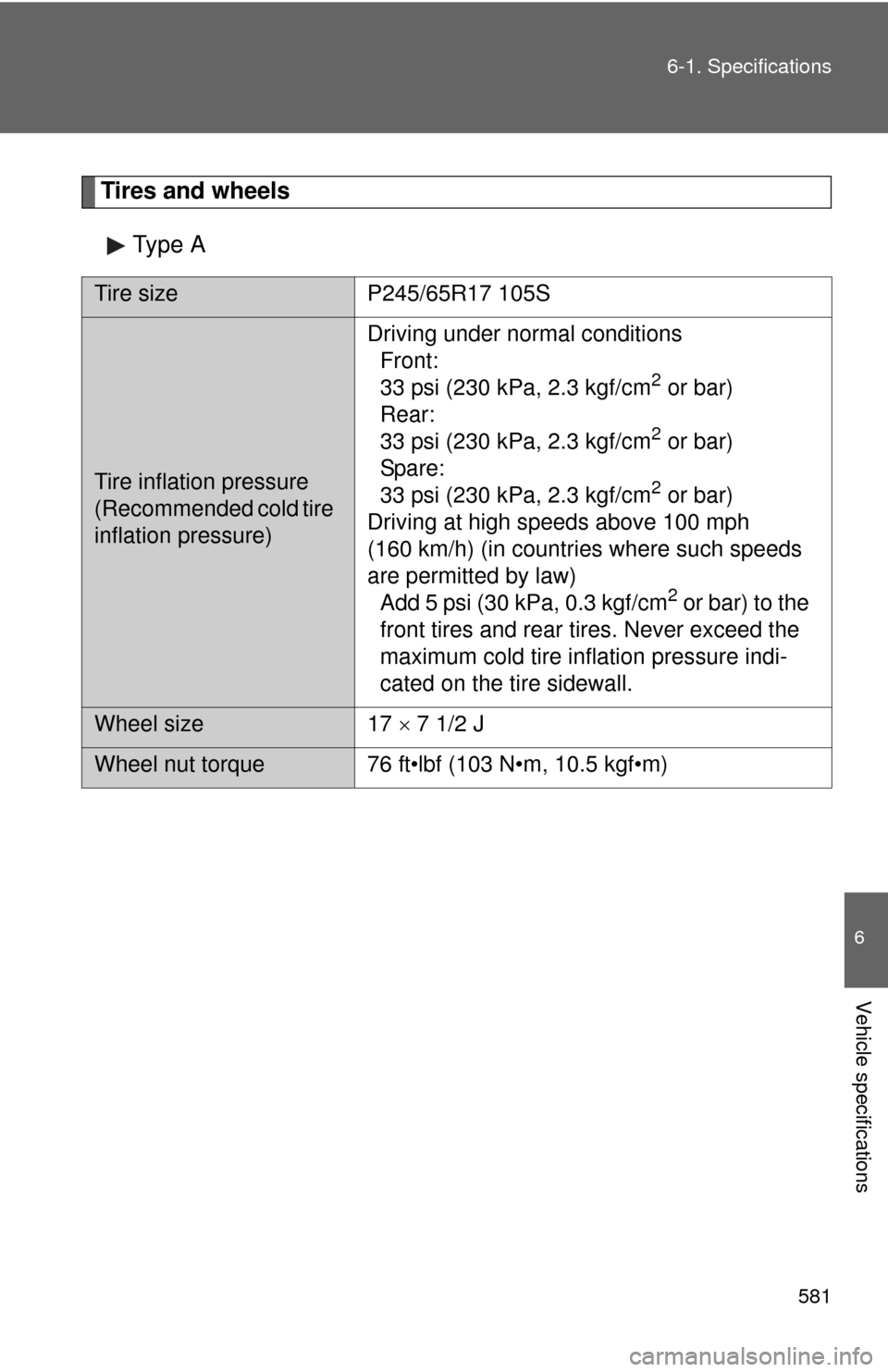
581
6-1. Specifications
6
Vehicle specifications
Tires and wheels
Type A
Tire size P245/65R17 105S
Tire inflation pressure
(Recommended cold tire
inflation pressure) Driving under normal conditions
Front:
33 psi (230 kPa, 2.3 kgf/cm
2 or bar)
Rear:
33 psi (230 kPa, 2.3 kgf/cm
2 or bar)
Spare:
33 psi (230 kPa, 2.3 kgf/cm
2 or bar)
Driving at high speeds above 100 mph
(160 km/h) (in countries where such speeds
are permitted by law) Add 5 psi (30 kPa, 0.3 kgf/cm
2 or bar) to the
front tires and rear tires. Never exceed the
maximum cold tire infl ation pressure indi-
cated on the tire sidewall.
Wheel size 17 7 1/2 J
Wheel nut torque 76 ft•lbf (103 N•m, 10.5 kgf•m)
Page 582 of 636
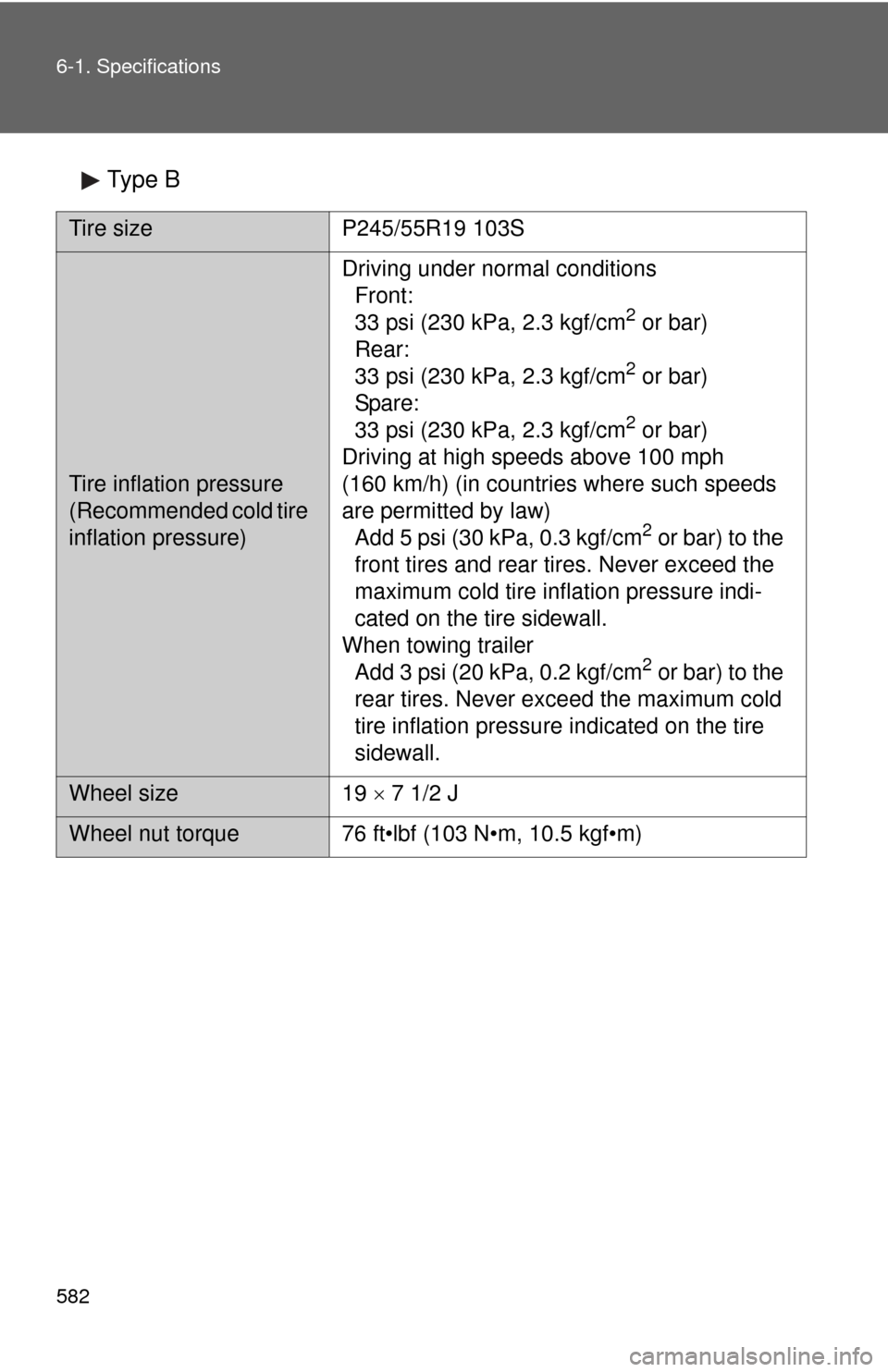
582 6-1. Specifications
Type B
Tire sizeP245/55R19 103S
Tire inflation pressure
(Recommended cold tire
inflation pressure) Driving under normal conditions
Front:
33 psi (230 kPa, 2.3 kgf/cm
2 or bar)
Rear:
33 psi (230 kPa, 2.3 kgf/cm
2 or bar)
Spare:
33 psi (230 kPa, 2.3 kgf/cm
2 or bar)
Driving at high speeds above 100 mph
(160 km/h) (in countries where such speeds
are permitted by law) Add 5 psi (30 kPa, 0.3 kgf/cm
2 or bar) to the
front tires and rear tires. Never exceed the
maximum cold tire infl ation pressure indi-
cated on the tire sidewall.
When towing trailer Add 3 psi (20 kPa, 0.2 kgf/cm
2 or bar) to the
rear tires. Never exceed the maximum cold
tire inflation pressure indicated on the tire
sidewall.
Wheel size 19 7 1/2 J
Wheel nut torque 76 ft•lbf (103 N•m, 10.5 kgf•m)
Page 583 of 636
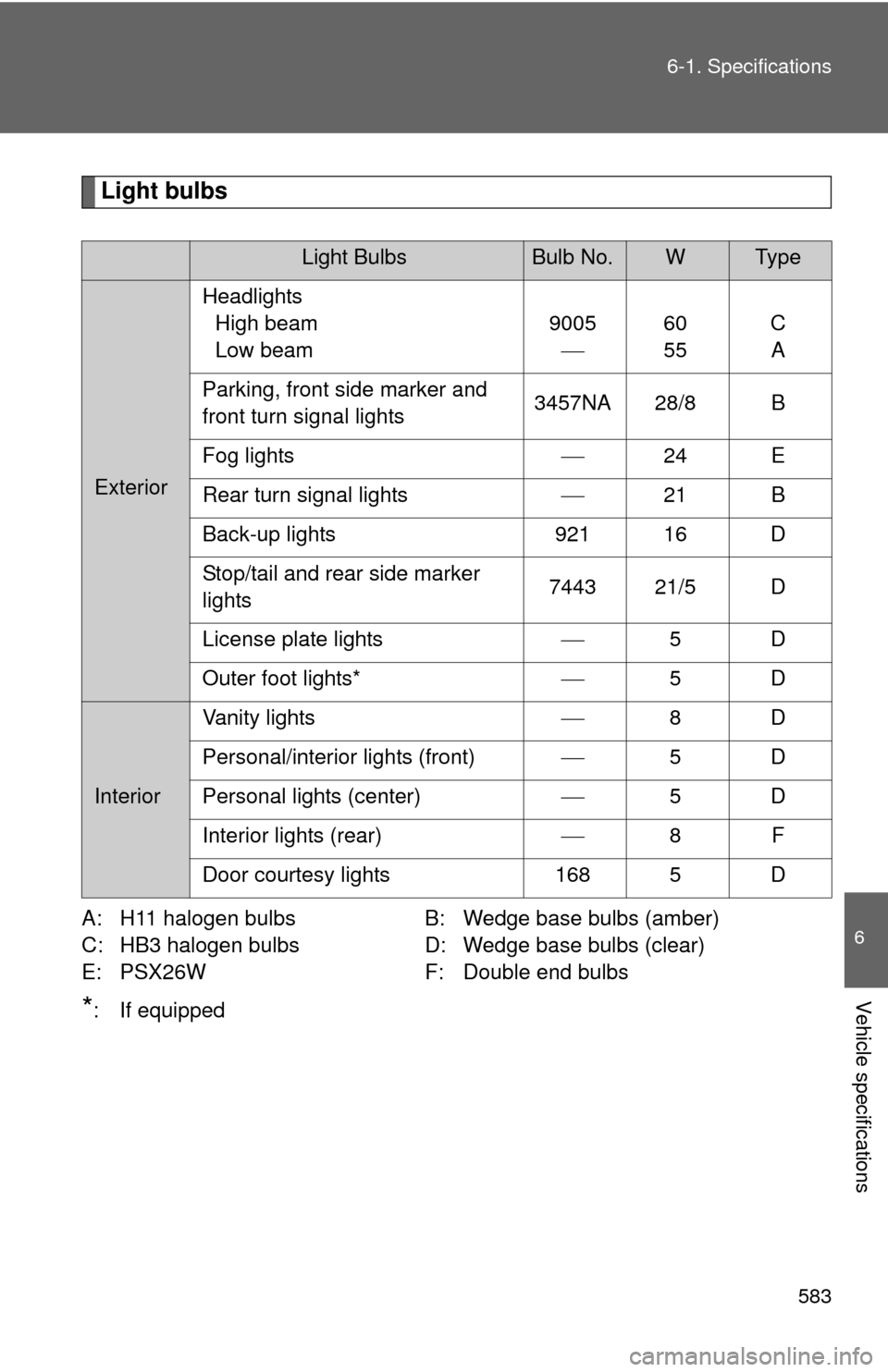
583
6-1. Specifications
6
Vehicle specifications
Light bulbs
A: H11 halogen bulbs
B: Wedge base bulbs (amber)
C: HB3 halogen bulbs D: Wedge base bulbs (clear)
E: PSX26W F: Double end bulbs
*: If equipped
Light BulbsBulb No.WTy p e
ExteriorHeadlights
High beam
Low beam 9005
60
55 C
A
Parking, front side marker and
front turn signal lights 3457NA 28/8 B
Fog lights 24 E
Rear turn signal lights 21 B
Back-up lights 921 16 D
Stop/tail and rear side marker
lights 7443 21/5 D
License plate lights 5D
Outer foot lights* 5D
Interior Vanity lights
8D
Personal/interior lights (front) 5D
Personal lights (center) 5D
Interior lights (rear) 8F
Door courtesy lights 168 5 D
Page 584 of 636
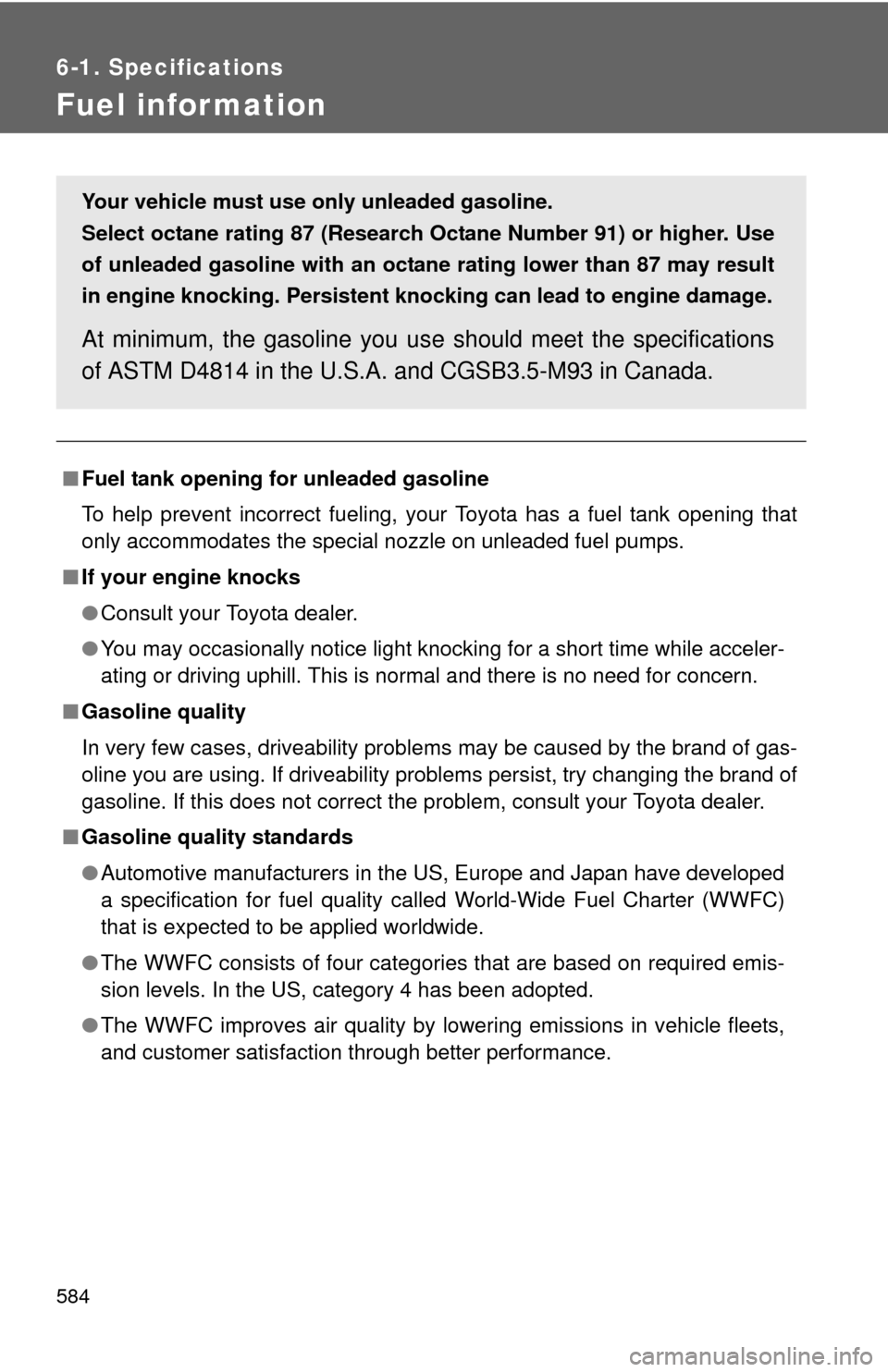
584
6-1. Specifications
Fuel infor mation
■Fuel tank opening fo r unleaded gasoline
To help prevent incorrect fueling, your Toyota has a fuel tank opening that
only accommodates the special nozzle on unleaded fuel pumps.
■ If your engine knocks
●Consult your Toyota dealer.
● You may occasionally notice light knocking for a short time while acceler-
ating or driving uphill. This is normal and there is no need for concern.
■ Gasoline quality
In very few cases, driveability problems may be caused by the brand of gas-
oline you are using. If driveability problems persist, try changing the brand of
gasoline. If this does not correct the problem, consult your Toyota dealer.
■ Gasoline quality standards
●Automotive manufacturers in the US, Europe and Japan have developed
a specification for fuel quality called World-Wide Fuel Charter (WWFC)
that is expected to be applied worldwide.
● The WWFC consists of four categories that are based on required emis-
sion levels. In the US, category 4 has been adopted.
● The WWFC improves air quality by lowering emissions in vehicle fleets,
and customer satisfaction through better performance.
Your vehicle must use only unleaded gasoline.
Select octane rating 87 (Research Octane Number 91) or higher. Use
of unleaded gasoline with an octane rating lower than 87 may result
in engine knocking. Persistent kno cking can lead to engine damage.
At minimum, the gasoline you use should meet the specifications
of ASTM D4814 in the U.S.A. and CGSB3.5-M93 in Canada.
Page 585 of 636
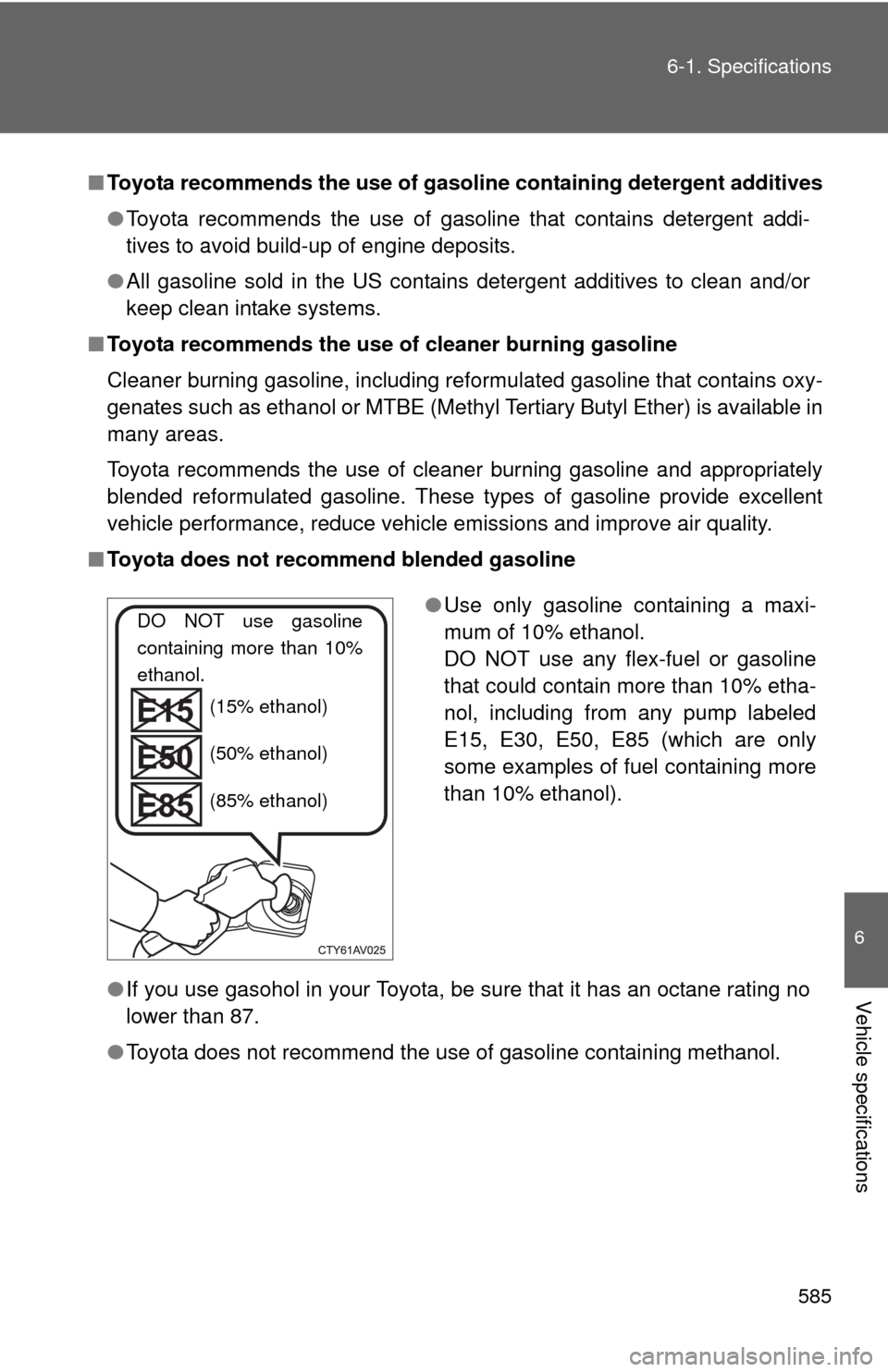
585
6-1. Specifications
6
Vehicle specifications
■
Toyota recommends the use of gaso line containing detergent additives
● Toyota recommends the use of gasoline that contains detergent addi-
tives to avoid build-up of engine deposits.
● All gasoline sold in the US contains detergent additives to clean and/or
keep clean intake systems.
■ Toyota recommends the use of cleaner burning gasoline
Cleaner burning gasoline, including reformulated gasoline that contains oxy-
genates such as ethanol or MTBE (Methyl Tertiary Butyl Ether) is available in
many areas.
Toyota recommends the use of cleaner burning gasoline and appropriately
blended reformulated gasoline. These types of gasoline provide excellent
vehicle performance, reduce vehicle emissions and improve air quality.
■ Toyota does not recommend blended gasoline
●If you use gasohol in your Toyota, be sure that it has an octane rating no
lower than 87.
● Toyota does not recommend the use of gasoline containing methanol.
●Use only gasoline containing a maxi-
mum of 10% ethanol.
DO NOT use any flex-fuel or gasoline
that could contain more than 10% etha-
nol, including from any pump labeled
E15, E30, E50, E85 (which are only
some examples of fuel containing more
than 10% ethanol).DO NOT use gasoline
containing more than 10%
ethanol.
(15% ethanol)
(50% ethanol)
(85% ethanol)
Page 586 of 636
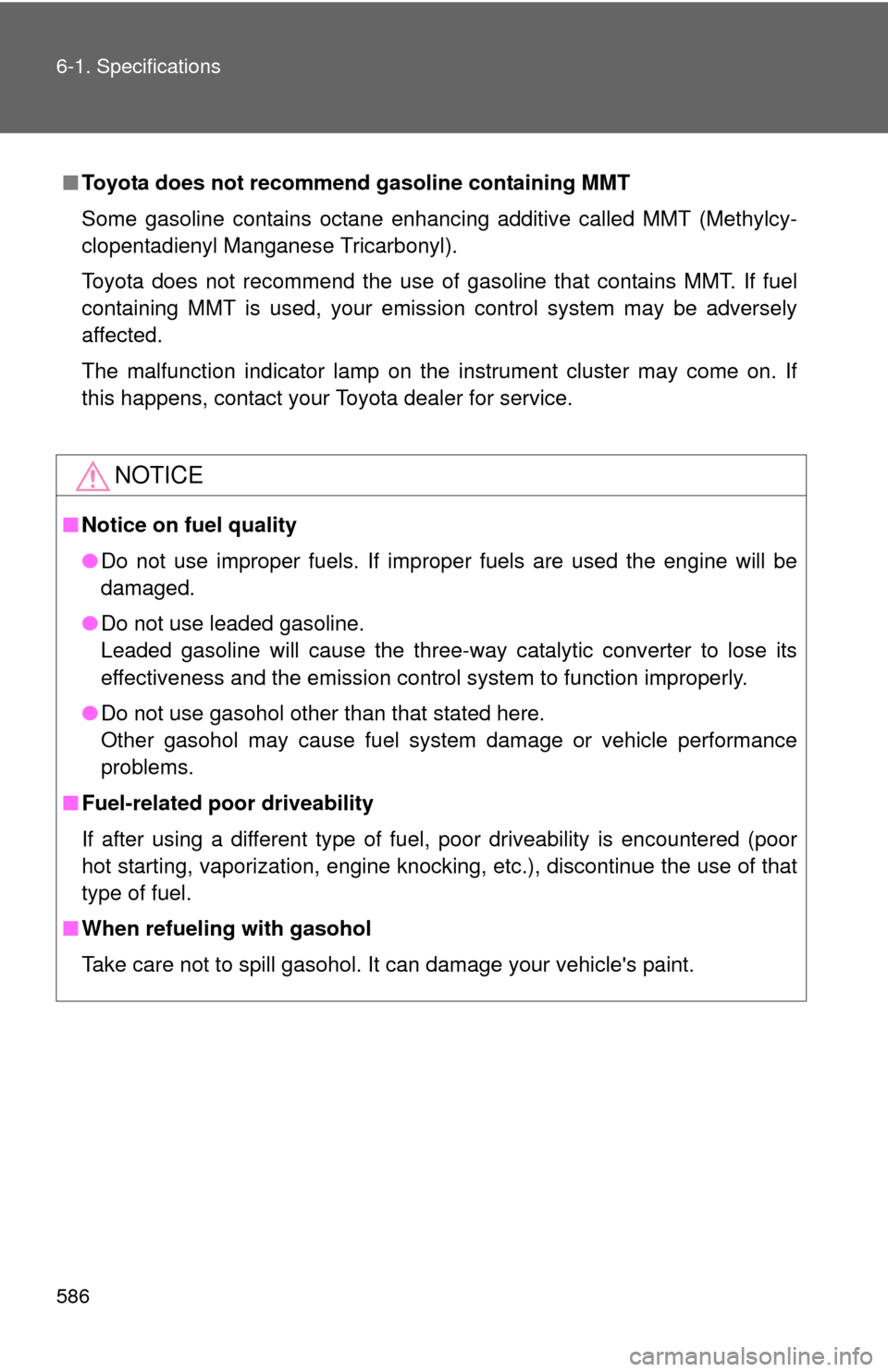
586 6-1. Specifications
■Toyota does not recommen d gasoline containing MMT
Some gasoline contains octane enhancing additive called MMT (Methylcy-
clopentadienyl Manganese Tricarbonyl).
Toyota does not recommend the use of gasoline that contains MMT. If fuel
containing MMT is used, your emission control system may be adversely
affected.
The malfunction indicator lamp on the instrument cluster may come on. If
this happens, contact your Toyota dealer for service.
NOTICE
■ Notice on fuel quality
●Do not use improper fuels. If improper fuels are used the engine will be
damaged.
● Do not use leaded gasoline.
Leaded gasoline will cause the three-way catalytic converter to lose its
effectiveness and the emission control system to function improperly.
● Do not use gasohol other than that stated here.
Other gasohol may cause fuel system damage or vehicle performance
problems.
■ Fuel-related poor driveability
If after using a different type of fuel, poor driveability is encountered (poor
hot starting, vaporization, engine knocking, etc.), discontinue the use of that
type of fuel.
■ When refueling with gasohol
Take care not to spill gasohol. It can damage your vehicle's paint.
Page 587 of 636
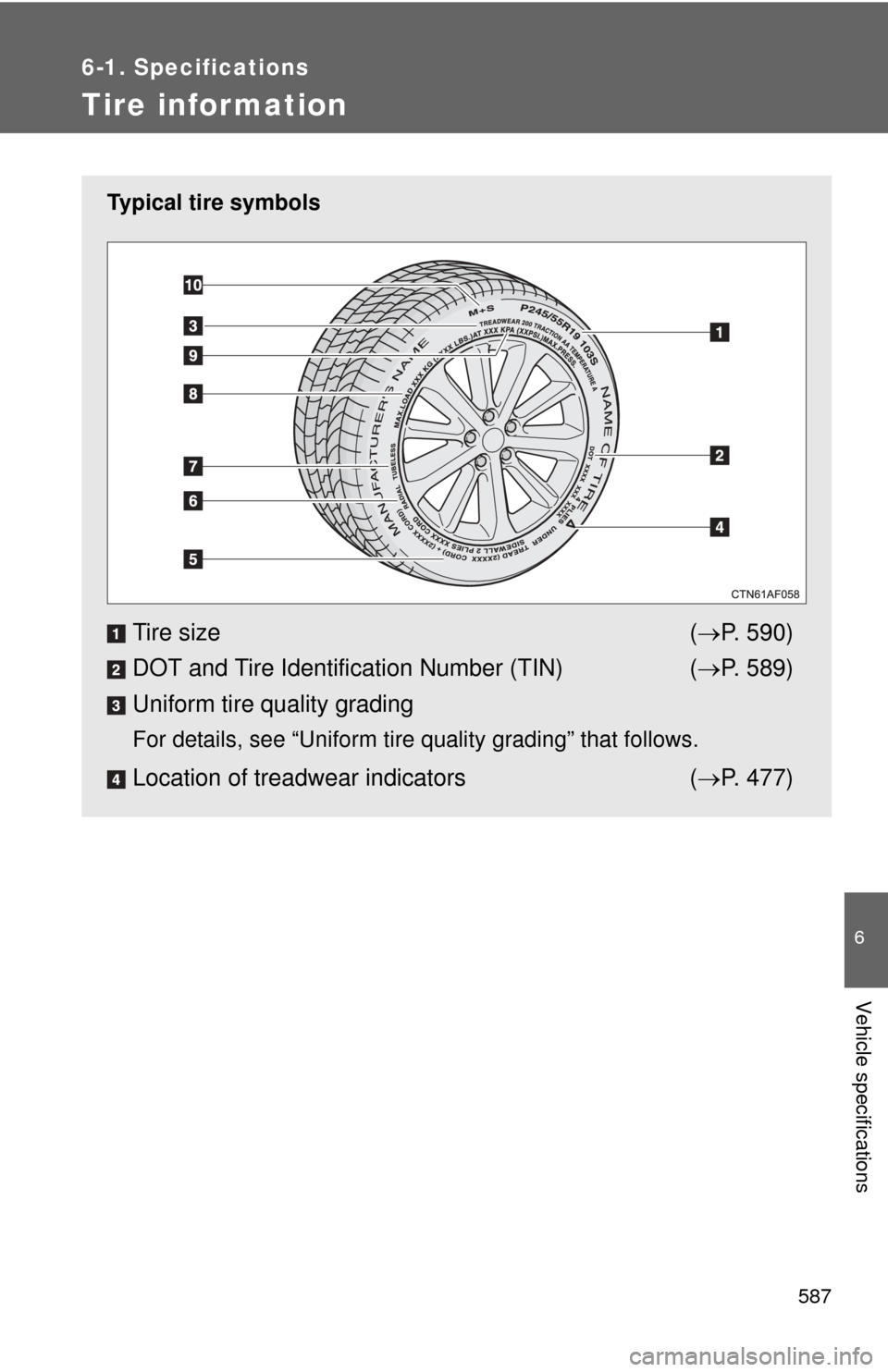
587
6-1. Specifications
6
Vehicle specifications
Tire infor mation
Typical tire symbols
Tire size( P. 590)
DOT and Tire Identification Number (TIN) ( P. 589)
Uniform tire quality grading
For details, see “Uniform tire quality grading” that follows.
Location of treadwear indicators ( P. 477)
Page 588 of 636
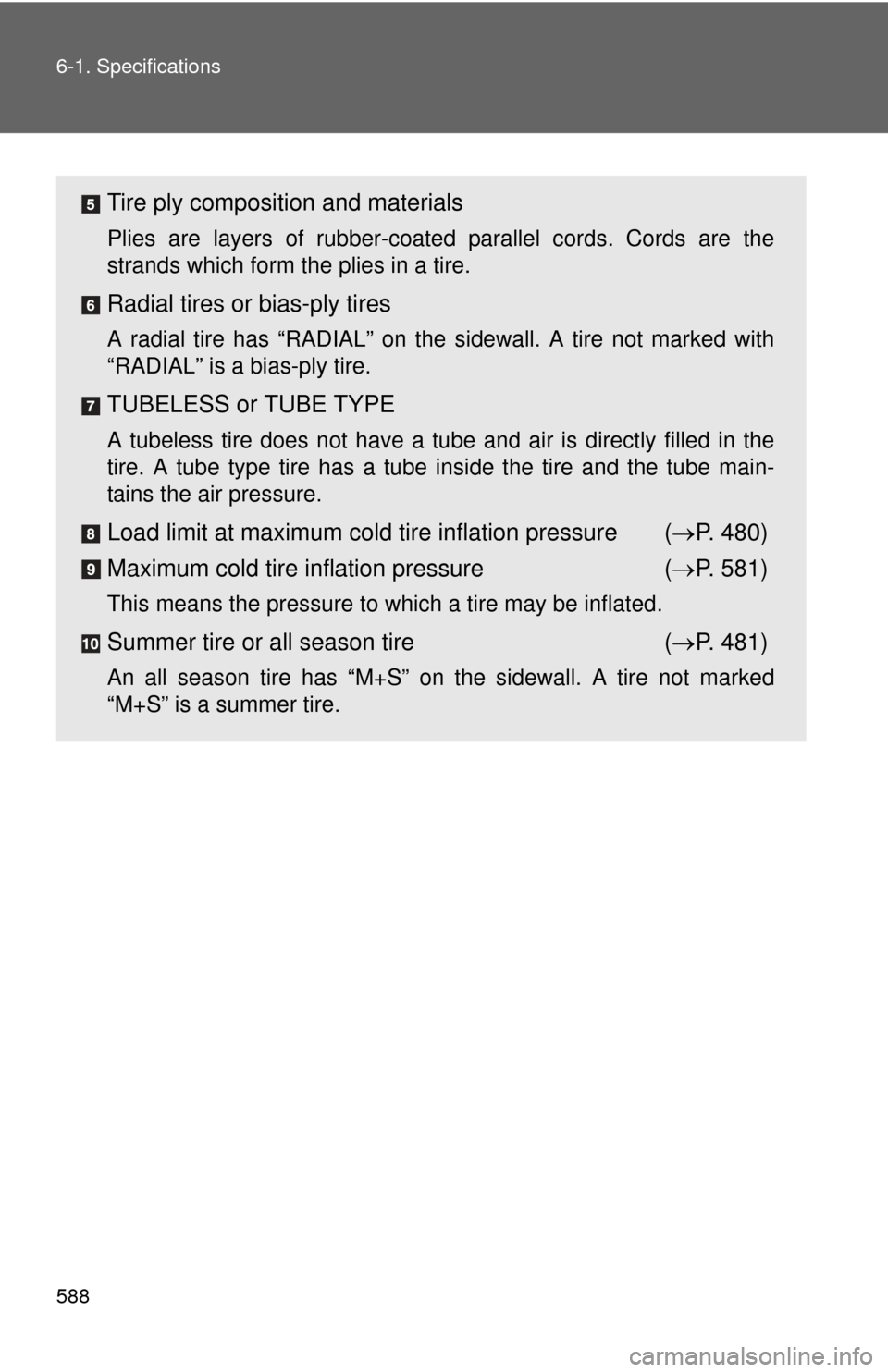
588 6-1. Specifications
Tire ply composition and materials
Plies are layers of rubber-coated parallel cords. Cords are the
strands which form the plies in a tire.
Radial tires or bias-ply tires
A radial tire has “RADIAL” on the sidewall. A tire not marked with
“RADIAL” is a bias-ply tire.
TUBELESS or TUBE TYPE
A tubeless tire does not have a tube and air is directly filled in the
tire. A tube type tire has a tube inside the tire and the tube main-
tains the air pressure.
Load limit at maximum cold tire inflation pressure ( P. 480)
Maximum cold tire in flation pressure ( P. 581)
This means the pressure to which a tire may be inflated.
Summer tire or all season tire ( P. 481)
An all season tire has “M+S” on the sidewall. A tire not marked
“M+S” is a summer tire.
Page 589 of 636
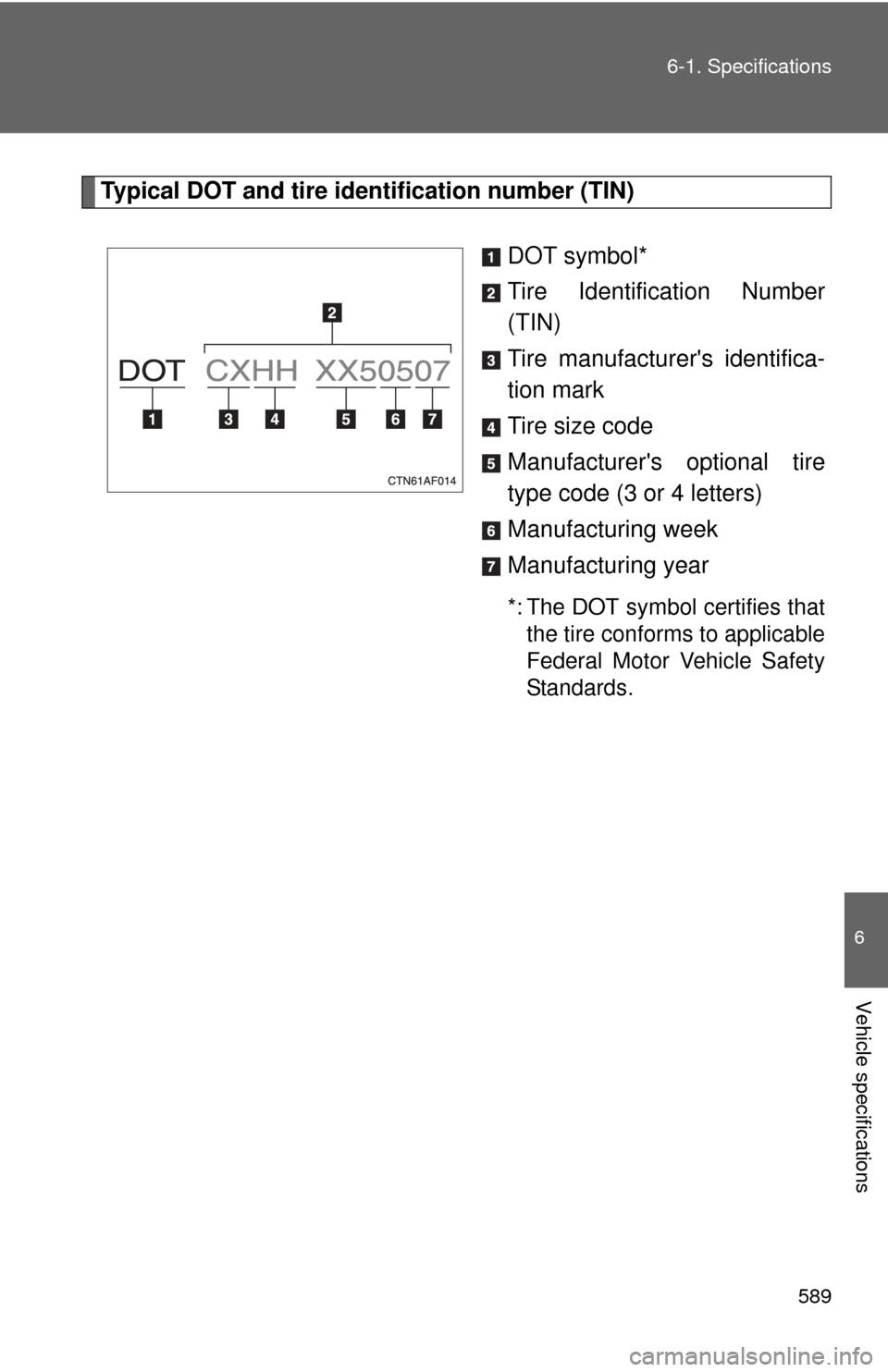
589
6-1. Specifications
6
Vehicle specifications
Typical DOT and tire identification number (TIN)
DOT symbol*
Tire Identification Number
(TIN)
Tire manufacturer's identifica-
tion mark
Tire size code
Manufacturer's optional tire
type code (3 or 4 letters)
Manufacturing week
Manufacturing year
*: The DOT symbol certifies thatthe tire conforms to applicable
Federal Motor Vehicle Safety
Standards.
Page 590 of 636
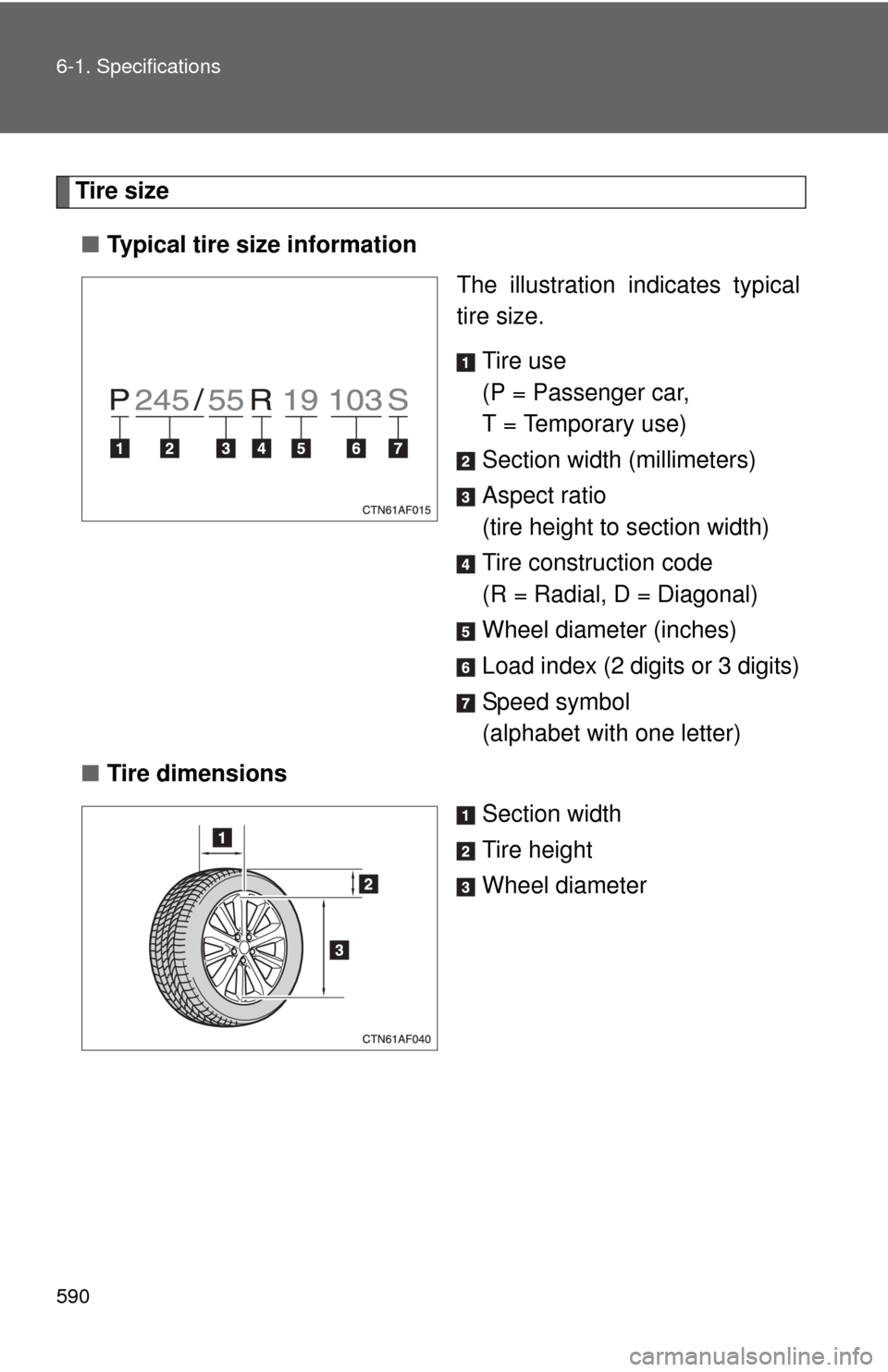
590 6-1. Specifications
Tire size■ Typical tire size information
The illustration indicates typical
tire size.
Tire use
(P = Passenger car,
T = Temporary use)
Section width (millimeters)
Aspect ratio
(tire height to section width)
Tire construction code
(R = Radial, D = Diagonal)
Wheel diameter (inches)
Load index (2 digits or 3 digits)
Speed symbol
(alphabet with one letter)
■ Tire dimensions
Section width
Tire height
Wheel diameter